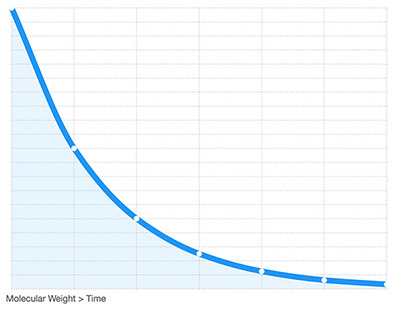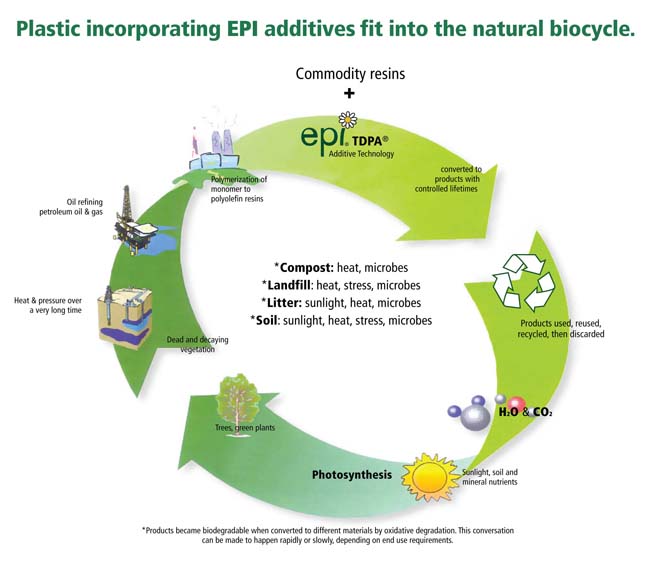
Here at Poly Postal Packaging, we use a number of different Oxo-Biodegradable additives in the manufacture of our Grey and Clear Eco-Bags. Here are some helpful details about just two of these:

ReverteTM is well suited to a wide range of processes and applications, has extensive food contact approvals and has been used for many years to provide a reliable and reproducible oxo-biodegradable property to plastics around the world.

The term ‘Oxo-biodegradability’ is a hybridisation of two words, oxidation and biodegradability. It defines clearly a two step process initiated in this case by the ReverteTM additive to degrade the polymer chain (break up) and make it available for biodegradability within the environment when a treated item has finished its useful life.
The phase of oxidation reduces the molecular weight and introduces oxygen into the structure. This process transforms the polymer from long strands to much smaller lengths. By reducing the chain length of the polymer the material loses its physical strength and elongation properties making it brittle and none ‘plastic’. The biodegradability aspect refers to the conversion of these lower molecular weight species by bacteria into biomass, CO2 and H2O in an aerobic environment, or in the case of an anaerobic environment, CH4.
ReverteTM is introduced to a plastic article such as a mailing bag at the manufacturing stage, the complex formulation is dosed in at a very low level, and the carefully developed complex additive package within ReverteTM is now within the plastic at a predetermined amount.
In the example below (a checkout bag found at most supermarkets) we can clearly see the effects and benefits of the ReverteTM process.





ReverteTM can modify polymer recipes...
The film is 'blown' as normal with no operational change to the process equipment or settings, this means that ReverteTM can modify polymer recipes making them oxo-biodegradable with only a small impact on cost and with minimum effort.
Once manufactured the check out bag now begins its useful life going from the production process through to warehousing, stock holding despatch and finally used by the customer and discarded into the waste stream in some form or another.
ReverteTM additive is activated by natural sunlight...
After the mailing bag is discarded the ReverteTM additive is activated by natural sunlight, this accelerates catalytic reaction to break the carbon-carbon (aliphatic) bonds at a molecular level and introduce oxygen into the polymer chain. This simple but effective reaction does two things, first it reduces the molecular weight of the polymer by 'chemically cutting' the chain, secondly it makes the molecular fragment more 'hydrophilic'.
The first physical observation is that as the chain scission occurs and the molecular weight of the polymer is reduced the plastic begins to lose its properties, its strength is lost and its elongation properties reduce, in effect the material becomes brittle. As the chain scission reaction continues the bag simply falls apart having no integral strength.troduced to a plastic article such as a mailing bag at the manufacturing stage, the complex formulation is dosed in at a very low level, and the carefully developed complex additive package within ReverteTM is now within the plastic at a predetermined amount.
The molecular weight has dropped...
It is a common misconception that this resultant powder is just smaller pieces of plastic, this is not the case. The molecular weight has dropped and oxygen has been introduced into these species, producing a complex mixture of carboxylic acids, ketones and alcohols. These lower molecular weight entities are not polymeric (the do not have sufficient repeating units to be classed as a polymer) and the material does not have any of the plastic properties which we associate with the polymer. It has therefore irreversibly changed beyond recognition.
The remnants are also hydrophilic which means they can be wetted out, unlike a normal polyolefin which is extremely hydrophobic. This is a critical parameter as it means that the carbon that was originally bound up in the polymer chain is now accessible and can be utilised by microbes, unlike when it was a polymeric chain and highly hydrophobic.
Available for biodigestion and are biodegradable...
In essence the polymer has been altered into a group of materials which are both available for biodigestion and are biodegradable. These materials if in a suitable environment which is rich in bacteria can now be safely biodegraded into the environment.
The biodegradation step rate is dependent on the environmental conditions in which it is exposed, this in fact is true for all biodegradable materials whether it be grass cuttings, straw or an oxo-biodegradable mailing bag!
This final step of converting the available carbon from the polymer into CO2 is called mineralisation, the rate at which CO2 is generated can be measured and provided with a ‘rate’ for this stage of biodigestion.
Carbonyl index...
The more carbonyls introduced the further removed it becomes from its polymeric nature. Once a critical point has been achieved in carbonyl index the polymer loses its flexibility and breaks apart under the minutest of stresses. At this time it is considered to be at its ‘embrittlement point’.
The profile of degradation...
What makes ReverteTM stand out is the profile of degradation, the curve plotted of carbonyl index versus time starts off very flat with a period of no change in the carbonyl index over time. This period is known as the ‘dwell time’.
After the dwell time has been passed the degradation then proceeds rapidly until the embrittlement point is reached and beyond that the plastic falls apart. The molecular weight is lowered and the material available for biodigestion.
Biodegradability...
Biodegradability of a ReverteTM treated film occurs once the molecular weight is below 5000. At this level the polymer no longer exists and is a wide range of discrete oxidised species. Bacteria and fungi find these species suitable for a source of carbon and can be assimilated into the lifecycle resulting in the formation of biomass and CO2 under aerobic conditions.
Biodegradation can only occur (whether this is for ReverteTM plastics or for grass cuttings) in environments which have warmth, bacterial activity and moisture. This fact is often overlooked when marketing oxo-biodegradable or hydrobiodegradable materials.

EPI develops, manufactures, distributes and sells chemical additives to manufacturers of finished plastic products in the packaging, agricultural and composting industries. The principal chemical additives sold by EPI are proprietary oxo-biodegradable plastic additives, Totally Degradable Plastic Additives (TDPA®).
EPI’s technology has been designed to control and manage the lifetime of products made from the most common plastics used by modern society. TDPA® based technology enables products made from polyethylene (PE), polypropylene (PP) and polystyrene (PS) to degrade* and, in most cases biodegrade*, when discarded, into environmentally benign products within a few months to a few years as compared to decades or longer for the same products made without the benefit of the technology.
EPI markets TDPA® to plastics converters around the world for inclusion into their existing product lines of disposable plastic products – primarily packaging materials and agricultural plastics. The technology is currently applied to products as diverse as retail carrier bags, foam packaging, stretch and shrink wraps and plastic serviceware.
With increasing public concern over plastic waste accumulation in recent years, the demand for biodegradable plastics is mounting. The plastics industry has tried various approaches to develop biodegradable plastics that can perform in the same way as conventional plastics. EPI’s oxo-biodegradable additive, TDPA®, is the most practical and economical product that makes plastics biodegrade relatively quickly in different disposal environment.
TDPA®, when added to PE, PP and PS resins, causes the plastic to degrade at a controlled rate. The degradation is triggered by exposure to ultraviolet light (sunlight), elevated temperatures or mechanical stress. The shelf life and service life of degradable and biodegradable plastic products incorporating TDPA® can be customized based on customer requirements ranging from a few months to years depending on the type and amount of TDPA® added to the plastic resin. Subsequent to the initial degradation, products made with polyethylene (such as grocery, shopping and garbage bags) are biodegradable.
Plastics incorporating TDPA® is processed, performs and is visually indistinguishable from conventional non-degradable plastic materials. They have similar physical properties as regular products prior to the onset of degradation. They are cost-competitive. They are also compatible with existing recycling operations and can be safely co-mingled with conventional plastic inputs prior to the onset of degradation.
TDPA® products are food contact compliant and meet applicable US, Canadian and European standards. Composts made from plastics incorporating TDPA® are found to have no toxic effect on sensitive plant or animal life.
How it works...
The chemical degradation process involves the reaction of very large polymer molecules of plastics, which contain only carbon and hydrogen, with oxygen in the air. This reaction occurs even without prodegradant additives but at a very slow rate. That is why conventional plastics, when discarded, persist for a long time in the environment. EPI’s TDPA® formulations catalyze or accelerate this reaction and increase the rate of the degradation by several orders of magnitude – i.e. 100’s to 1000’s of times faster, making TDPA® incorporated products degrade and physically disintegrate within a few weeks to 1-2 years, depending on the formulation and the disposal environment.
These lower molecular weight fragments are known to, and have been shown, in laboratory simulated composts, to biodegrade into carbon dioxide, water and biomass (cell structure of micro-organisms), which are materials found in nature and part of the biocycle. Commercially available LDPE films incorporating TDPA® have been shown to convert 60% of their carbon backbone into carbon dioxide in 1.5-2 years with most of the balance of the carbon remaining as micro-organism cells. Unmodified films would take much longer to achieve this.
The chemistry described above has been well known to polymer scientists for years. Indeed manufacturers of polymer resins routinely add antioxidant chemicals to their products to prevent any oxidation during thermal processing into products. EPI’s contribution lies in its ability to manage these processes in a predictable way – to balance the effect of its catalytic additives with the effect of contained antioxidants in order to make products that satisfy needs for adequate shelf and service lives while providing degradation/biodegradation rates suitable for the final disposal environment.
A useful feature of catalyzed oxo-degradation chemistry is that, as long as there is any residual antioxidant in the plastic, the catalytic additive has absolutely no effect. These antioxidants are slowly consumed as they do their job. This fact is important in designing shelf and service life of TDPA® incorporated products and allow these products to be safely recycled in existing recycle streams prior to them exhibiting visual signs of degradation – brittleness or disintegration. Other practical features of the technology are that it is applied to the most common commercially available and used polymers and does not affect the processability or the other properties of these polymers.
The overall process, from polymer to water, carbon dioxide and biomass is called oxo-biodegradation. EPI is the pioneer and world’s leading practitioner of oxo-biodegradable technology and has the experience and technical knowledge to design additive systems for polyethylene, polypropylene and polystyrene to meet widely varying needs for shelf and service life and degradation performance in a range of disposal medium and situations.
Poly Postal Packaging January 2018



